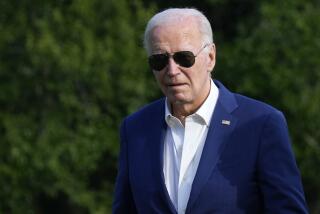Nixon in Serious Condition After Suffering Stroke
NEW YORK — Former President Richard Nixon suffered a stroke Monday evening and was rushed by ambulance from his home in New Jersey to a hospital here, where he was reported in serious but stable condition in an intensive care unit.
The 81-year-old former chief executive, the only President ever forced to resign his office, had not spoken since the stroke occurred at 5:45 p.m. as he was preparing for dinner at his home in Park Ridge, N.J., spokeswoman Kim Taylor said. After falling ill, Nixon managed to summon the housekeeper, who called an ambulance, Taylor said.
“The doctors said he is in stable condition,” said New York Mayor Rudolph W. Giuliani, who met at New York Hospital-Cornell Medical Center with Nixon’s daughter Tricia Cox. Nixon’s other daughter, Julie Nixon Eisenhower, was en route to his bedside.
“He did have a stroke,” Giuliani said. “He is not able to speak. . . . He has not spoken yet.”
Nixon was being treated with anticoagulants.
Evangelist Billy Graham, a close family friend, arrived at the hospital on Manhattan’s Upper East Side late Monday to offer comfort. “He means a great deal to me,” Graham said. “I preached at his wife’s funeral in California. I have a great personal affection for him.” Pat Nixon died last year of lung cancer.
“Given his virtual indestructible character, it’s hard to think that President Nixon could have anything like this happen to him,” said Kenneth L. Khachigian, a Republican consultant in San Clemente who served as a speech writer in the Nixon White House.
Khachigian, who is also on the board of directors of the Nixon Library in Yorba Linda, said he was concerned about Nixon’s health but optimistic that he will quickly recover.
As the nation’s 37th President, Nixon served in the White House from January, 1969, to August, 1974, when he resigned to avoid impeachment in the Watergate scandal.
Few political figures in the nation’s history have been so controversial and so enduring. In later years, Nixon adopted the role of elder statesman, quietly advising presidents and traveling the world.
A month ago, he traveled to Russia, where he appeared in good health. During the visit, he met with such opposition leaders as Alexander Rutskoi and Vladimir Zhirinovsky. Those conferences drew displeasure from Russian President Boris N. Yeltsin.
Nixon said he planned to report to President Clinton on the results of the visit.
After serving for eight years as Dwight D. Eisenhower’s vice president, Nixon was defeated by John F. Kennedy in the tightly contested 1960 presidential election.
But eight years after that loss, Nixon ran again and was elected with a pledge to end the Vietnam War. On Jan. 27, 1973, a cease-fire was signed in Paris. By the time of the signing, he had won a second term in a landslide over Sen. George S. McGovern, an anti-war Democratic activist.
The former President began his career in California as a dedicated anti-communist congressman. But as commander-in-chief, he moved the United States dramatically closer to China and established a policy of detente with the Soviet Union, negotiating arms control agreements with its leaders.
For a time he retreated from the limelight after Watergate, but later regained public attention through his travels, speeches, articles and books.
But his association with Watergate never really faded. In 1986, a Gallup Poll reported that three-fourths of those surveyed still thought Nixon deserved to be forced from the White House.
A month after Nixon resigned, his successor, Gerald R. Ford, pardoned him for all crimes that Nixon “committed or may have committed or taken part in” during his term in office.
“While I was not involved in the decision to conduct the break-in, I should have set a higher standard for the conduct of the people who participated in my campaign and Administration,” Nixon said. “I should have established a moral tone that would have made such actions unthinkable. I did not,” he wrote in his ninth book, “In the Arena.”
Nixon said he viewed Watergate--the break-in by White House operatives at the offices of the Democratic National Committee at the Watergate office complex--as “one major defeat in a career that involved both victories and losses, both peaks and valleys.”
In 1974, soon after leaving the White House, Nixon suffered a life-threatening attack of phlebitis and complications from surgery to contain the blood clots in his legs.
In 1985, doctors successfully removed a cancerous tumor from behind his left ear.
In 1986, he was hospitalized for treatment of a viral infection, and in 1988 he underwent minor hernia surgery.
Strokes afflict an estimated 500,000 people in the United States every year, killing 150,000, making them the third-leading cause of death in the country. More than 70% of strokes occur in people over the age of 65.
The most common kind of stroke is a thrombosis, blockage of a blood vessel in the brain by a clot that has gradually built up on the wall of an artery in the brain. Next most common is an embolism, a similar blockage caused by a clot that forms elsewhere in the body and moves to the brain. Nixon has a history of clot formation in his legs, so this is most likely the type he had. The least common type of stroke is a hemorrhage, bleeding within the brain caused by the rupture of a blood vessel.
Blockage of a blood vessel impedes the flow of oxygen to brain cells in the immediate area, leading to their death if the flow is not restored quickly. When these cells die, parts of the body they control can’t function, causing impairment of movement, speech and even thought. The impairment is usually permanent because dead brain cells do not regenerate.
In an attempt to forestall cell death, physicians frequently use tPA, a biotechnology-based drug commonly used in heart attacks, to try to dissolve the clot. Blood thinners, such as aspirin, warfarin and heparin, are also used to reduce the risk of further clot formation.
Times medical writer Thomas H. Maugh II in Los Angeles contributed to this story.
More to Read
Sign up for Essential California
The most important California stories and recommendations in your inbox every morning.
You may occasionally receive promotional content from the Los Angeles Times.










